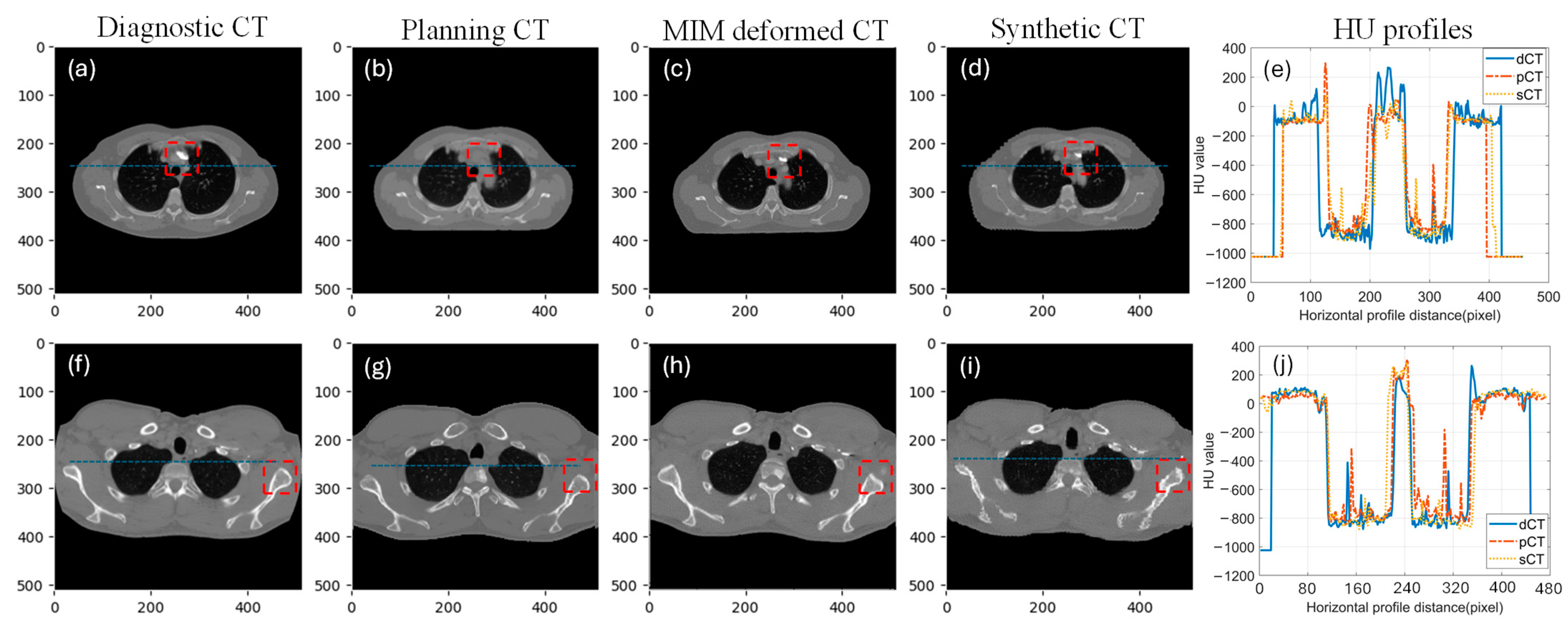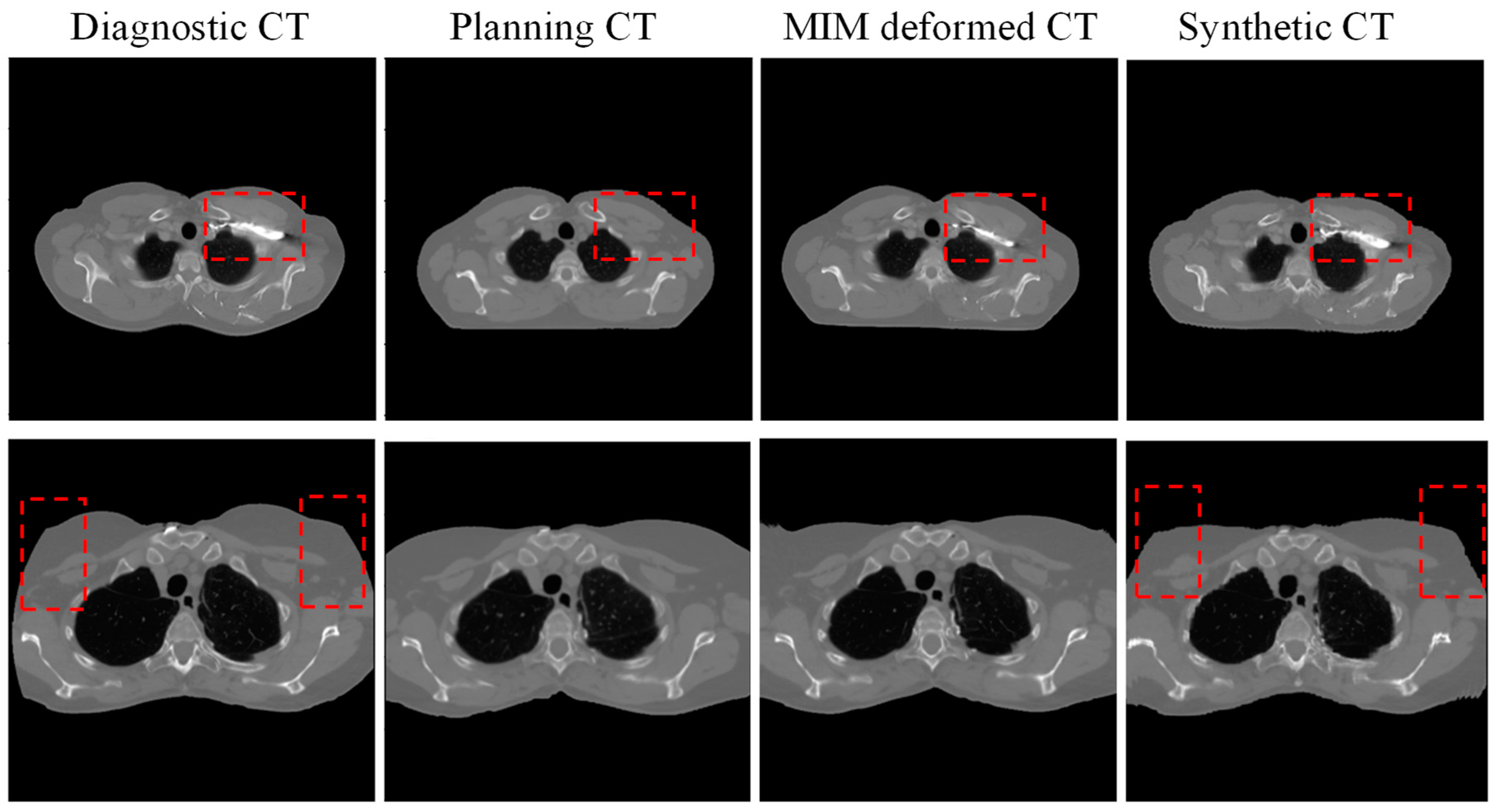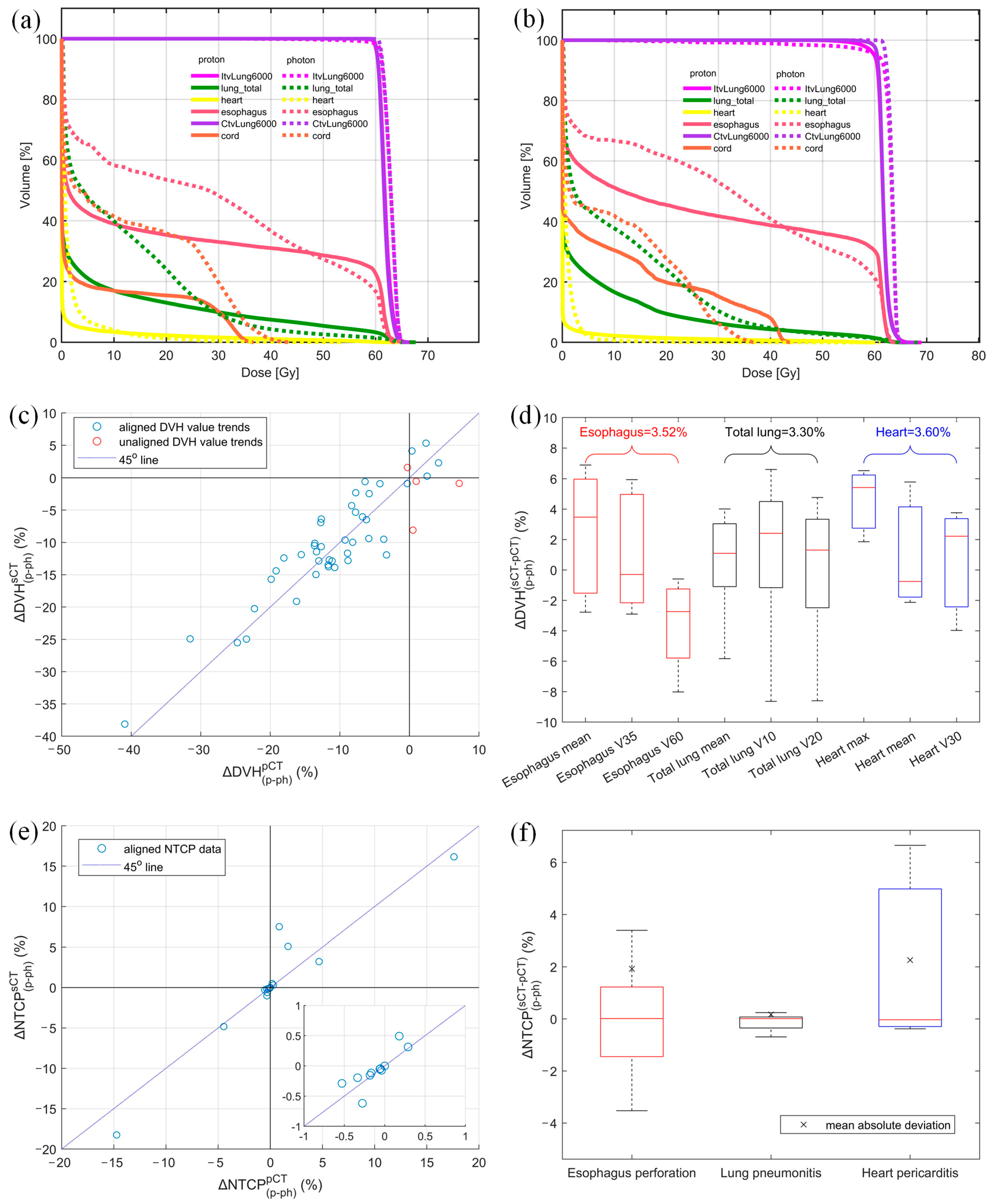Deep Learning-Based Synthetic CT for Personalized Treatment Modality Selection Between Proton and Photon Therapy in Thoracic Cancer
Simple Summary
Abstract
1. Introduction
2. Materials and Methods
2.1. Synthetic-CT Workflow for Informed Physician–Patient Consultation
2.2. Network Architecture
2.2.1. Image Pre-Processing and Training
2.2.2. Image Evaluation Metrics
2.3. Treatment Planning for Dosimetric Assessment
2.4. NTCP Calculation for Treatment Modality Selection
3. Results
3.1. Qualitative Comparison of AI-Predicted sCT and pCT
3.2. Quantitative Comparison Between AI-Predicted sCT and Commercial Algorithm Deformed MdCT
3.3. DVH Metric Comparison Between sCT and pCT for Selected Critical OARs
3.4. NTCP Alignment and Quantitative Deviation Between sCT and pCT
4. Discussion
5. Conclusions
Supplementary Materials
Author Contributions
Funding
Institutional Review Board Statement
Informed Consent Statement
Data Availability Statement
Conflicts of Interest
Abbreviations
| sCT | Synthetic CT |
| pCT | Planning CT |
| dCT | Diagnostic CT |
| MdCT | Deformed CT using commercial software (MIM) |
| NTCP | Normal tissue complication probability |
| VMAT | Volumetric modulated arc therapy |
| PBS | Pencil beam scanning |
| MAE | Mean absolute error |
| UQI | Universal quality index |
| DL | Deep learning |
| CCC | Concordance correlation coefficient |
| DVH | Dose-volume histogram |
| AI | Artificial intelligence |
| HU | Hounsfield unit |
| CBCT | Cone beam CT |
| OAR | Organ at risk |
| SSIMLoss | Structural similarity index measure loss |
| DVF | Deformation vector field |
| DVH deviation between proton and photon plans created using sCT | |
| DVH deviation between proton and photon plans created using pCT | |
| DVH value agreement between sCT and pCT | |
| NTCP deviation between proton and photon plans created using sCT | |
| NTCP deviation between proton and photon plans created using pCT | |
| NTCP value agreement between sCT and pCT |
References
- Lundkvist, J.; Ekman, M.; Ericsson, S.R.; Jönsson, B.; Glimelius, B. Proton therapy of cancer: Potential clinical advantages and cost-effectiveness. Acta Oncol. 2005, 44, 850–861. [Google Scholar] [CrossRef] [PubMed]
- Peeters, A.; Grutters, J.P.C.; Pijls-Johannesma, M.; Reimoser, S.; De Ruysscher, D.; Severens, J.L.; Joore, M.A.; Lambin, P. How costly is particle therapy? Cost analysis of external beam radiotherapy with carbon-ions, protons and photons. Radiother. Oncol. 2010, 95, 45–53. [Google Scholar] [CrossRef]
- Baumann, B.C.; Mitra, N.; Harton, J.G.; Xiao, Y.; Wojcieszynski, A.P.; Gabriel, P.E.; Zhong, H.; Geng, H.; Doucette, A.; Wei, J.; et al. Comparative Effectiveness of Proton vs Photon Therapy as Part of Concurrent Chemoradiotherapy for Locally Advanced Cancer. JAMA Oncol. 2020, 6, 237–246. [Google Scholar] [CrossRef]
- Gunther, J.R.; Rahman, A.R.; Dong, W.; Yehia, Z.A.; Kebriaei, P.; Rondon, G.; Pinnix, C.C.; Milgrom, S.A.; Allen, P.K.; Dabaja, B.S.; et al. Craniospinal irradiation prior to stem cell transplant for hematologic malignancies with CNS involvement: Effectiveness and toxicity after photon or proton treatment. Pract. Radiat. Oncol. 2017, 7, e401–e408. [Google Scholar] [CrossRef] [PubMed]
- Hyer, D.E.; Ding, X.; Rong, Y. Proton therapy needs further technological development to fulfill the promise of becoming a superior treatment modality (compared to photon therapy). J. Appl. Clin. Med. Phys. 2021, 22, 4–11. [Google Scholar] [CrossRef] [PubMed]
- ASTRO Model Policies. PROTON BEAM THERAPY (PBT). 2022. Available online: https://www.astro.org/ASTRO/media/ASTRO/Daily%20Practice/PDFs/ASTROPBTModelPolicy.pdf (accessed on 1 May 2024).
- Teoh, S.; Fiorini, F.; George, B.; Vallis, K.A.; Van den Heuvel, F. Normal tissue complication probability (NTCP) models for modern radiation therapy. Semin. Oncol. 2019, 46, 210–218. [Google Scholar]
- Walsh, S.; Roelofs, E.; Kuess, P.; Van Wijk, Y.; Vanneste, B.; Dekker, A.; Lambin, P.; Jones, B.; Georg, D.; Verhaegen, F. Towards a Clinical Decision Support System for External Beam Radiation Oncology Prostate Cancer Patients: Proton vs. Photon Radiotherapy? A Radiobiological Study of Robustness and Stability. Cancers 2018, 10, 55. [Google Scholar] [CrossRef]
- Suit, H.; DeLaney, T.; Goldberg, S.; Paganetti, H.; Clasie, B.; Gerweck, L.; Niemierko, A.; Hall, E.; Flanz, J.; Hallman, J. Proton vs carbon ion beams in the definitive radiation treatment of cancer patients. Radiother. Oncol. 2010, 95, 3–22. [Google Scholar] [CrossRef]
- Zhou, P.; Du, Y.; Zhang, Y.; Zhu, M.; Li, T.; Tian, W.; Wu, T.; Xiao, Z. Efficacy and Safety in Proton Therapy and Photon Therapy for Patients With Esophageal Cancer: A Meta-Analysis. JAMA Netw. Open 2023, 6, e2328136. [Google Scholar] [CrossRef]
- Echeverria, A.E.; McCurdy, M.; Castillo, R.; Bernard, V.; Ramos, N.V.; Buckley, W.; Castillo, E.; Liu, P.; Martinez, J.; Guerrero, T. Proton therapy radiation pneumonitis local dose–response in esophagus cancer patients. Radiother. Oncol. 2013, 106, 124–129. [Google Scholar] [CrossRef]
- Liao, Z.; Lee, J.J.; Komaki, R.; Gomez, D.R.; O’Reilly, M.S.; Fossella, F.V.; Blumenschein, G.R., Jr.; Heymach, J.V.; Vaporciyan, A.A.; Swisher, S.G.; et al. Bayesian Adaptive Randomization Trial of Passive Scattering Proton Therapy and Intensity-Modulated Photon Radiotherapy for Locally Advanced Non–Small-Cell Lung Cancer. J. Clin. Oncol. 2018, 36, 1813–1822. [Google Scholar] [CrossRef] [PubMed]
- Teoh, S.; Fiorini, F.; George, B.; Vallis, K.A.; Van den Heuvel, F. Proton vs photon: A model-based approach to patient selection for reduction of cardiac toxicity in locally advanced lung cancer. Radiother. Oncol. 2020, 152, 151–162. [Google Scholar] [CrossRef] [PubMed]
- Gupta, A.; Khan, A.J.; Goyal, S.; Millevoi, R.; Elsebai, N.; Jabbour, S.K.; Yue, N.J.; Haffty, B.G.; Parikh, R.R. Insurance approval for proton beam therapy and its impact on delays in treatment. Int. J. Radiat. Oncol. Biol. Phys. 2019, 104, 714–723. [Google Scholar] [CrossRef]
- Belyea, J.; Rigby, M.; Jaggi, R.; Hart, R.D.; Trites, J.; Taylor, S.M. Wait Times for Head and Neck Cancer Patients in the Maritime Provinces. J. Otolaryngol. -Head Neck Surg. 2011, 40, 318–322. [Google Scholar]
- Robinson, D.; Massey, T.; Davies, E.; Jack, R.; Sehgal, A.; Møller, H. Waiting times for radiotherapy: Variation over time and between cancer networks in southeast England. Br. J. Cancer 2005, 92, 1201–1208. [Google Scholar] [CrossRef] [PubMed]
- Chen, Z.; King, W.; Pearcey, R.; Kerba, M.; Mackillop, W.J. The relationship between waiting time for radiotherapy and clinical outcomes: A systematic review of the literature. Radiother. Oncol. 2008, 87, 3–16. [Google Scholar] [CrossRef]
- Choan, E.; Dahrouge, S.; Samant, R.; Mirzaei, A.; Price, J. Radical radiotherapy for cervix cancer: The effect of waiting time on outcome. Int. J. Radiat. Oncol. Biol. Phys. 2005, 61, 1071–1077. [Google Scholar]
- Khorana, A.A.; Tullio, K.; Elson, P.; Pennell, N.A.; Grobmyer, S.R.; Kalady, M.F.; Raymond, D.; Abraham, J.; Klein, E.A.; Walsh, R.M. Time to initial cancer treatment in the United States and association with survival over time: An observational study. PLoS ONE 2019, 14, e0213209. [Google Scholar]
- Kidar, H.S.; Azizi, H. Enhancement of Hounsfield unit distribution in cone-beam CT images for adaptive radiation therapy: Evaluation of a hybrid correction approach. Phys. Medica: Eur. J. Med. Phys. 2020, 69, 269–274. [Google Scholar] [CrossRef]
- Manduca, A.; Erickson, B.J.; Persons, K.R.; Palisson, P.M. Histogram transformation for improved compression of CT images. In Medical Imaging 1997: Image Display; SPIE: Newport Beach, CA, USA, 1997. [Google Scholar]
- Hooshangnejad, H.; Chen, Q.; Feng, X.; Zhang, R.; Farjam, R.; Voong, R.; Hales, R.; Du, Y.; Jia, X.; Ding, K. DAART: A Deep Learning Platform for Deeply Accelerated Adaptive Radiation Therapy for Lung Cancer. Front. Oncol. 2023, 13, 1201679. [Google Scholar] [CrossRef]
- Glober, G.; Kubli, A.; Kielbasa, J.; Chauhan, B.; Burch, D.; Holmes, T.; Willoughby, T.R.; Ramakrishna, N.; Rineer, J.M.; Dvorak, T. Technical report: Diagnostic scan-based planning (DSBP), a method to improve the speed and safety of radiation therapy for the treatment of critically ill patients. Pract. Radiat. Oncol. 2020, 10, e425–e431. [Google Scholar] [CrossRef]
- Hooshangnejad, H.; Ding, K. Feasibility of planning-CT-free rapid workflow for stereotactic body radiotherapy: Removing the need for planning CT by AI-driven, intelligent prediction of body deformation. In Medical Imaging 2022: Image-Guided Procedures, Robotic Interventions, and Modeling; SPIE: San Diego, CA, USA, 2022. [Google Scholar]
- Hooshangnejad, H.; Chen, Q.; Feng, X.; Zhang, R.; Ding, K. deepPERFECT: Novel Deep Learning CT Synthesis Method for Expeditious Pancreatic Cancer Radiotherapy. Cancers 2023, 15, 3061. [Google Scholar] [CrossRef]
- Cardoso, M.J.; Li, W.; Brown, R.; Ma, N.; Kerfoot, E.; Wang, Y.; Murray, B.; Myronenko, A.; Zhao, C. MONAI: An open-source framework for deep learning in healthcare. arXiv 2022, arXiv:2211.02701. [Google Scholar]
- Milliron, T.; Jensen, R.J.; Barzel, R.; Finkelstein, A. A framework for geometric warps and deformations. ACM Trans. Graph. 2002, 21, 20–51. [Google Scholar] [CrossRef]
- Kazuhiro, A.; Noriyuki, K.; Takahiro, K.; Hiromitsu, E.; Shinya, K.; Yoshitomo, A.; Tatsuya, N.; Hitoshi, W.; Yasuhiro, K.; Yoshihiro, T.; et al. Feasibility of CBCT-based proton dose calculation using a histogram-matching algorithm in proton beam therapy. Phys. Medica 2017, 33, 68–76. [Google Scholar]
- Yusuke, O.; Noriyuki, K.; Yukio, F.; Kazuhiro, A.; Suguru, D.; Ken, T.; Kazuma, K.; Rei, U.; Haruo, M.; Keiichi, J. Evaluation of On-Board kV Cone Beam Computed Tomography–Based Dose Calculation With Deformable Image Registration Using Hounsfield Unit Modifications. Int. J. Radiat. Oncol. Biol. Phys. 2014, 89, 416–423. [Google Scholar]
- Grossberg, A.; Elhalawani, H.; Mohamed, A.; Mulder, S.; Williams, B.; White, A.L.; Zafereo, J.; Wong, A.J.; Berends, J.E.; AboHashem, S.; et al. Anderson Cancer Center Head And Neck Quantitative Imaging Working Group. HNSCC (Version 4) [Data set]. The Cancer Imaging Archive. 2020. [Google Scholar] [CrossRef]
- Vallières, M.; Kay-Rivest, E.; Perrin, L.J.; Liem, X.; Furstoss, C.; Khaouam, N.; Nguyen-Tan, P.F.; Wang, C.-S.; Sultanem, K. Data from Head-Neck-PET-CT (Version 2) [Data set]. The Cancer Imaging Archive. 2017. [CrossRef]
- Zhou, W.; Bovik, A.C. A universal image quality index. IEEE Signal Process. Lett. 2002, 9, 81–84. [Google Scholar] [CrossRef]
- Haldun, A. User’s guide to correlation coefficients. Turk. J. Emerg. Med. 2018, 18, 91–93. [Google Scholar]
- Lyman, J.T. Complication probability as assessed from dose-volume histograms. Radiat. Res. 1985, 104, S13–S19. [Google Scholar] [CrossRef]
- Kutcher, G.J.; Burman, C. Calculation of complication probability factors for non-uniform normal tissue irradiation: The effective volume method gerald. Int. J. Radiat. Oncol. Biol. Phys. 1989, 16, 1623–1630. [Google Scholar] [CrossRef]
- Emami, B.; Lyman, J.; Brown, A.; Cola, L.; Goitein, M.; Munzenrider, J.; Shank, B.; Solin, L.; Wesson, M. Tolerance of normal tissue to therapeutic irradiation. Int. J. Radiat. Oncol. Biol. Phys. 1991, 21, 109–122. [Google Scholar] [CrossRef] [PubMed]
- Yoo, S.; Yin, F.-F. Dosimetric feasibility of cone-beam CT-based treatment planning compared to CT-based treatment planning. Int. J. Radiat. Oncol. Biol. Phys. 2006, 66, 1553–1561. [Google Scholar] [CrossRef] [PubMed]
- Lenkowicz, J.; Votta, C.; Nardini, M.; Quaranta, F.; Catucci, F.; Boldrini, L.; Vagni, M.; Menna, S.; Placidi, L.; Romano, A.; et al. A deep learning approach to generate synthetic CT in low field MR-guided radiotherapy for lung cases. Radiother. Oncol. 2022, 176, 31–38. [Google Scholar] [CrossRef] [PubMed]
- Li, X.; Bellotti, R.; Meier, G.; Bachtiary, B.; Weber, D.; Lomax, A.; Buhmann, J.; Zhang, Y. Uncertainty-aware MR-based CT synthesis for robust proton therapy planning of brain tumour. Radiother. Oncol. 2024, 191, 110056. [Google Scholar] [CrossRef]
- Isensee, F.; Jaeger, P.F.; Kohl, S.A.A.; Petersen, J.; Maier-Hein, K.H. nnU-Net: A self-configuring method for deep learning-based biomedical image segmentation. Nat. Methods 2021, 18, 203–211. [Google Scholar] [CrossRef]
- Chlap, P.; Min, H.; Vandenberg, N.; Dowling, J.; Holloway, L.; Haworth, A. A review of medical image data augmentation techniques for deep learning applications. J. Med. Imaging Radiat. Oncol. 2021, 65, 545–563. [Google Scholar] [CrossRef]





| Scanning Parameters | Public Data | Institutional Data | |||
| dCT | pCT | dCT | pCT | ||
| Manufacturer | GE | Philips | Philips | GE | Siemens |
| Convolution kernel | SOFT | B | B | - | Br38s |
| kVp (kV) | 120 | 120 | 120 | 120 | 120 |
| Data collection diameter (mm) | 500 | 500 | 500 | 500 | 500 |
| X ray tube current (mA) | 296 | 297 | 333 | 232 | 177 |
| Exposure (mAs) | 20 | 250 | 77 | 15 | 221 |
| Filter type | Body filter | B | B | Standard | FLAT |
| Pixel spacing (mm) | 0.9766 | 0.9766 | 0.9766 | 0.9766 | 0.9766 |
| Metric | MdCT vs. pCT | sCT vs. pCT |
| MAE | 19.55 ± 3.78 HU | 38.93 ± 14.79 HU |
| UQI | 0.90 ± 0.02 | 0.84 ± 0.05 |
Disclaimer/Publisher’s Note: The statements, opinions and data contained in all publications are solely those of the individual author(s) and contributor(s) and not of MDPI and/or the editor(s). MDPI and/or the editor(s) disclaim responsibility for any injury to people or property resulting from any ideas, methods, instructions or products referred to in the content. |
© 2025 by the authors. Licensee MDPI, Basel, Switzerland. This article is an open access article distributed under the terms and conditions of the Creative Commons Attribution (CC BY) license (https://creativecommons.org/licenses/by/4.0/).
Share and Cite
Zhu, L.; Yu, N.Y.; Tegtmeier, R.C.; Ashman, J.B.; Anand, A.; Duan, J.; Chen, Q.; Rong, Y. Deep Learning-Based Synthetic CT for Personalized Treatment Modality Selection Between Proton and Photon Therapy in Thoracic Cancer. Cancers 2025, 17, 1553. https://doi.org/10.3390/cancers17091553
Zhu L, Yu NY, Tegtmeier RC, Ashman JB, Anand A, Duan J, Chen Q, Rong Y. Deep Learning-Based Synthetic CT for Personalized Treatment Modality Selection Between Proton and Photon Therapy in Thoracic Cancer. Cancers. 2025; 17(9):1553. https://doi.org/10.3390/cancers17091553
Chicago/Turabian StyleZhu, Libing, Nathan Y. Yu, Riley C. Tegtmeier, Jonathan B. Ashman, Aman Anand, Jingwei Duan, Quan Chen, and Yi Rong. 2025. "Deep Learning-Based Synthetic CT for Personalized Treatment Modality Selection Between Proton and Photon Therapy in Thoracic Cancer" Cancers 17, no. 9: 1553. https://doi.org/10.3390/cancers17091553
APA StyleZhu, L., Yu, N. Y., Tegtmeier, R. C., Ashman, J. B., Anand, A., Duan, J., Chen, Q., & Rong, Y. (2025). Deep Learning-Based Synthetic CT for Personalized Treatment Modality Selection Between Proton and Photon Therapy in Thoracic Cancer. Cancers, 17(9), 1553. https://doi.org/10.3390/cancers17091553






